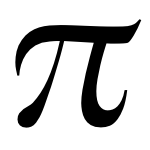 Here's a piece I wrote for curiousmath about 2-3 years ago, and I thought I'd post it here, since it would be of interest to Grey Matters readers.
Here's a piece I wrote for curiousmath about 2-3 years ago, and I thought I'd post it here, since it would be of interest to Grey Matters readers.
This piece is all about dividing a 2-, 3- or 4-digit number by a 1 digit number, and doing so with decimal precision. When presented, it comes across as much harder than it really is. With a little practice, you can have a very impressive feat under your belt that's ready at a moment's notice.
First, you need to remember all the possible decimal equivalents for each single digit divisor. Most people will already know the first few decimal equivalents:
1/2=.5
1/3=.333...
2/3=.666...
1/4=.25
2/4=1/2=.5
3/4=.75
What are the rest? 5ths are easy, as you simply double the dividend, and place the decimal in front of that number:
1/5=.2
2/5=.4
3/5=.6
4/5=.8
With 6th, you already know 3 of the 5 decimals from above:
2/6=1/3=.333...
3/6=1/2=.5
4/6=2/3=.666...
You simply need to learn just two more 6ths:
1/6=.1666...
5/6=.8333...
7ths have a very unique pattern! Let's start with 1/7:
1/7=.142857142857142857...
All you have to do for 7ths is to remember the sequence 142857 (which repeats over and over again). Each 7th will always contain this same sequence, and only the starting point will change!
To find the appropriate starting point, take the dividend and multiply it by 14 (you should be able to do up to 14*6 in your head fairly quickly of course). Find the place in the 142857 sequence closest to this number, and you'll have the appropriate starting place!
Starting again with 1/7, we simply think (1*14=14, so 1/7 starts at the 14, and is thus equal to .142857142857...)
Here's how you figure the rest of the 7ths, with the thought process in parentheses:
2/7 (2*14=28)=.2857142857142857...
3/7 (3*14=42)=.42857142857142857...
4/7 (4*14=56)=.57142857142857...
5/7 (5*14=70)=.7142857142857...
6/7 (6*14=84)=.857142857142857...
Once you see the pattern and practice it, 7ths are very simple.
8ths are also very simple, as they are half-steps in-between the 4ths. Simply multiply the dividend by 125, and place the decimal in front of it:
1/8=.125
2/8=1/4=.25
3/8=.375
4/8=1/2=.5
5/8=.625
6/8=3/4=.75
7/8=.875
9ths seem like they should be hard, but all you have to do is repeat the dividend over and over:
1/9=.111...
2/9=.222...
3/9=.333...
4/9=.444...
5/9=.555...
6/9=.666...
7/9=.777...
8/9=.888...
Just for reference, 10ths and 11ths aren't hard, and can be done in your head easily, as well.
For 10ths, simply place a decimal in front of the dividend:
1/10=.1
2/10=.2
3/10=.3
4/10=.4
5/10=.5
6/10=.6
7/10=.7
8/10=.8
9/10=.9
For 11ths, you need to know your 9 times table up to 10:
1/11=.090909...
2/11=.181818...
3/11=.272727...
4/11=.363636...
5/11=.454545...
6/11=.545454...
7/11=.636363...
8/11=.727272...
9/11=.818181...
10/11=.909090...
With a little practice, these decimal equivalents will come to mind quickly.
Now for the full feat. To keep things simple, start working with 2 digit numbers.
Have someone choose any 2-digit number and any 1-digit number, and you can announce the result of dividing the larger number by the smaller one. For example, let's say they choose 59 divided by 6.
You should quickly realize that the closest multiple of 6 to 59, without going over, is 54 (6*9). So, the answer is 9 and 5/6ths. Instead of saying it that way, however, you remember 5/6 = 0.833, and so the answer is 9.833.
People see decimals as very complex, so this is very impressive, yet not hard to do.
For 3- and 4-digit numbers, you need to practice working through the division problem from left to right in your head.
Starting with a 3-digit example, let's try 698 divided by 7. Beginning with the leftmost digit, we quickly see that 7 won't go into 6, so we move to the next digit. 7 will go into 69 nine times, so our answer is 90-something. Taking away 63 (7*9), that leaves us with 68 to work with. 7 can go into 68 nine times, as well, so that gives us 99, with 5 as a remainder, or 99 and 5/7ths. Remember the decimal equivalent of 5/7ths? This means you can give the answer as 99.7142857 in short order.
4-digits work the same way, with one extra step, of course. 4732 divided by 6? Let's try it:
4/6=won't work
47/6=7, carrying the 5 (47-42=5), so it's 700 something
53/6=8, carrying the 5 (53-48=5), so it's 780 something
52/6=8, carrying the 4 (52-48=4), so it's 788 and 4/6, or 788 2/3
Translated into decimal form, you say "788.666".
Even if you never get comfortable with 4-digit numbers, dividing 3-digit numbers by 1-digit numbers is still impressive, especially when you can carry it out to many decimal places.
Tips:
1) Regular practice will help increase your speed. You can get to the point where you can do it as quick as (or possibly even quicker than) a calculator!
2) Fractions seem a more "human" way of giving the answer, as they don't seem as precise (2/3 is much easier to understand than .666..., as 2/3 doesn't go on forever). Stating the answer in decimals is strongly associated with precision, the way a computer would give the answer, so the decimals give a stronger impression of a computer-like (or "Rain Man"-like) skills in math.
3) You'll find that people choose 7 more often than any other number for the 1-digit number, as it seems harder to most people. As you've seen above, not only are 7ths easier to deal with, but the ability to carry the decimal result out to 6, 7 or 8 decimal places with no decernable pattern makes it more impressive, as well!

 Sporcle has gone and done it!
Sporcle has gone and done it!

 Have you been practicing
Have you been practicing One of my most embarrassing moments in my life concerns a time I was teaching a trick based on the Gilbreath Principles.
One of my most embarrassing moments in my life concerns a time I was teaching a trick based on the Gilbreath Principles. As we get 2009 going, it seems like a good time to challenge your brain with the calendar.
As we get 2009 going, it seems like a good time to challenge your brain with the calendar.

 Here's a piece I wrote for
Here's a piece I wrote for  It's a new year, so I'm using this
It's a new year, so I'm using this  Happy New Year!
Happy New Year!

